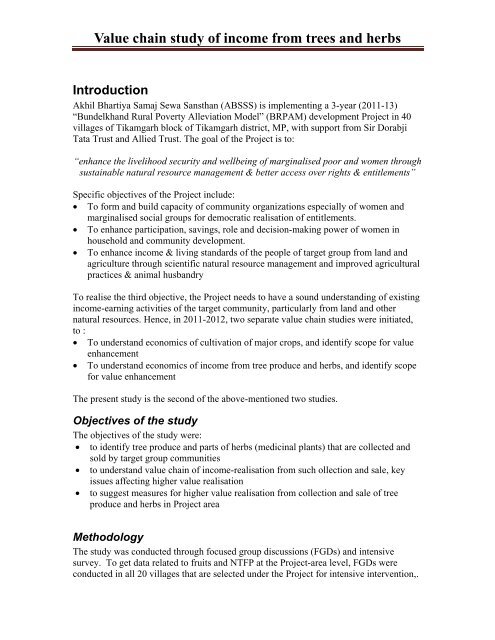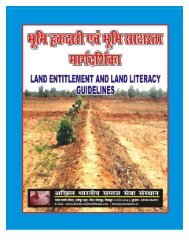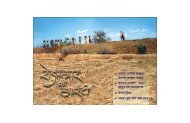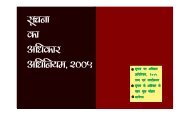Value chain study of income from trees and herbs - ABSSS
Value chain study of income from trees and herbs - ABSSS
Value chain study of income from trees and herbs - ABSSS
Create successful ePaper yourself
Turn your PDF publications into a flip-book with our unique Google optimized e-Paper software.
<strong>Value</strong> <strong>chain</strong> <strong>study</strong> <strong>of</strong> <strong>income</strong> <strong>from</strong> <strong>trees</strong> <strong>and</strong> <strong>herbs</strong><br />
Introduction<br />
Akhil Bhartiya Samaj Sewa Sansthan (<strong>ABSSS</strong>) is implementing a 3-year (2011-13)<br />
“Bundelkh<strong>and</strong> Rural Poverty Alleviation Model” (BRPAM) development Project in 40<br />
villages <strong>of</strong> Tikamgarh block <strong>of</strong> Tikamgarh district, MP, with support <strong>from</strong> Sir Dorabji<br />
Tata Trust <strong>and</strong> Allied Trust. The goal <strong>of</strong> the Project is to:<br />
“enhance the livelihood security <strong>and</strong> wellbeing <strong>of</strong> marginalised poor <strong>and</strong> women through<br />
sustainable natural resource management & better access over rights & entitlements”<br />
Specific objectives <strong>of</strong> the Project include:<br />
To form <strong>and</strong> build capacity <strong>of</strong> community organizations especially <strong>of</strong> women <strong>and</strong><br />
marginalised social groups for democratic realisation <strong>of</strong> entitlements.<br />
To enhance participation, savings, role <strong>and</strong> decision-making power <strong>of</strong> women in<br />
household <strong>and</strong> community development.<br />
To enhance <strong>income</strong> & living st<strong>and</strong>ards <strong>of</strong> the people <strong>of</strong> target group <strong>from</strong> l<strong>and</strong> <strong>and</strong><br />
agriculture through scientific natural resource management <strong>and</strong> improved agricultural<br />
practices & animal husb<strong>and</strong>ry<br />
To realise the third objective, the Project needs to have a sound underst<strong>and</strong>ing <strong>of</strong> existing<br />
<strong>income</strong>-earning activities <strong>of</strong> the target community, particularly <strong>from</strong> l<strong>and</strong> <strong>and</strong> other<br />
natural resources. Hence, in 2011-2012, two separate value <strong>chain</strong> studies were initiated,<br />
to :<br />
To underst<strong>and</strong> economics <strong>of</strong> cultivation <strong>of</strong> major crops, <strong>and</strong> identify scope for value<br />
enhancement<br />
To underst<strong>and</strong> economics <strong>of</strong> <strong>income</strong> <strong>from</strong> tree produce <strong>and</strong> <strong>herbs</strong>, <strong>and</strong> identify scope<br />
for value enhancement<br />
The present <strong>study</strong> is the second <strong>of</strong> the above-mentioned two studies.<br />
Objectives <strong>of</strong> the <strong>study</strong><br />
The objectives <strong>of</strong> the <strong>study</strong> were:<br />
to identify tree produce <strong>and</strong> parts <strong>of</strong> <strong>herbs</strong> (medicinal plants) that are collected <strong>and</strong><br />
sold by target group communities<br />
to underst<strong>and</strong> value <strong>chain</strong> <strong>of</strong> <strong>income</strong>-realisation <strong>from</strong> such ollection <strong>and</strong> sale, key<br />
issues affecting higher value realisation<br />
to suggest measures for higher value realisation <strong>from</strong> collection <strong>and</strong> sale <strong>of</strong> tree<br />
produce <strong>and</strong> <strong>herbs</strong> in Project area<br />
Methodology<br />
The <strong>study</strong> was conducted through focused group discussions (FGDs) <strong>and</strong> intensive<br />
survey. To get data related to fruits <strong>and</strong> NTFP at the Project-area level, FGDs were<br />
conducted in all 20 villages that are selected under the Project for intensive intervention,.






